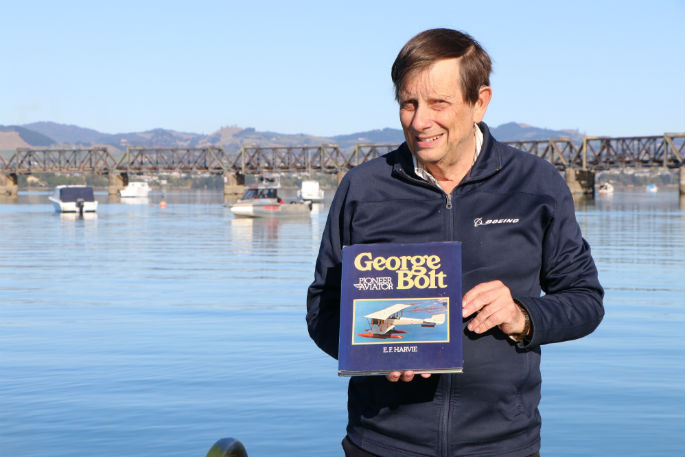It's a story that starts with a bespectacled timber salesman and a dashing Naval lieutenant having a drink at the salubrious University Club in Seattle.
Then the story comes to a very graceful landing on Tauranga Harbour at the foot of Wharf Street.
It was 1:08pm on Sunday, March 14, 1920 - almost 100 years ago.
'And it was significant because it was the very first time an aeroplane had visited Tauranga,” explains Classic Flyers aviation museum archivist, Peter Layne. 'Most Tauranga people hadn't seen an aeroplane before.”
There was wide-eyed excitement along the Strand, hakas, speeches, dinners, toasts and the presentation of a handsome pair of ebony hairbrushes to the skipper of the 'big bird” or 'machine” as reports of the time described the B&W seaplane. This was March 1920. These were momentous and dizzying times.
'It was one of the very first two planes built by Bill [William E.] Boeing says Peter Layne. 'Fascinating but true.”
Bill Boeing was the timber salesman having a tipple with the Naval lieutenant Conrad Westervelt in Seattle. They shared a passion for aviation and jumped at every opportunity for a ride in the sky.
And after one such flight, in a Curtiss floatplane, Boeing remarked that 'there isn't much to that machine… I think we could build a better one.” So they did – the Boeing Model 1 B&W Seaplane – two of them, described by one aviation writer as the first in a line of innovative, pioneering vehicles that have defined aerospace and helped change the world.
And there was one of the Model 1s, on that day in March 1920, bobbing about on the tide opposite the old Commercial Hotel at the bottom of Wharf Street. The pillars of the new rail bridge were the backdrop. 'I am not sure whether Boeing had simply moved on to bigger and better projects or the seaplanes had become surplus, or how it was discovered they were for sale, but they were shipped out to the New Zealand Flying School at Kohimarama Beach in Auckland for training WW1 pilots.”
The flying school numbered the aircraft Fleet F and Fleet G. 'F did most of the work and G apparently wasn't a very good aircraft,” says Peter. Something about poor lateral control and sluggish aileron response. 'They modified it and made it better, but F got all the recognition.”
Why are we dusting off this moment in history nine months short of the anniversary? Well, the whiff of av' gas excites most of us, and Boeing's been in the news a lot of late. Air New Zealand announced it's buying eight new Boeing 787-10 Dreamliners with a list value of more than $4 billion.
Closer to home there was an annual luncheon at Classic Flyers for former NAC staff – the former domestic wing of Air New Zealand – NAC, 'The wings of the Nation”. They also celebrated the 50th anniversary of the introduction of the Boeing 737. Boeing's director for Asia Pacific sales, Erika Pearson even dropped in for the occasion. Coincidentally it was the centenary of William E. Boeing's Model 1s arriving in New Zealand and next March the centenary of F flying into Tauranga.
It's interesting to see how far aeronautics, and Boeing, have come in 100 years. For example, the unit price for a Dreamliner is US$248 million, has a wingspan of 60 metres, and a range of 13,000 kilometres. Its predecessor, the B&W seaplane was sold to New Zealand 100 years ago for US$3,750, had a wingspan of 16 metres and ran out of gas after 500 kilometres.
When F dropped 'dexterously” into Tauranga, as a report of the time said, the man at the controls was a George Bolt – a pioneer pilot and brilliant aircraft engineer. 'He was an instructor with the flying school. He was also the experimental airmail flight pilot and transported homing pigeons.” The main access to Auckland International Airport carries his name.
'Auckland's Bishop Henry Cleary saw the opportunity to get around the country to see his flock,” says Peter. 'He would help with the mail and he didn't mind getting his feet wet. George obviously considered him an adventurer and pioneer in his own right.”
The Bishop also thought flying was good for the soul. He's quoted in E.F.Harvie's book on Bolt – 'Travelling at 60 miles an hour or more through the clean and dustless upper air provides a tonic effect”.
Anyhow, Tauranga was so happy to see the man of faith, cum mailman, cum adventurer, they gave him a gold watch. And at 6.47am, on Monday, March 15 Bolt and the Bishop skipped across the harbour in their seaplane and out of Tauranga, passing Tairua and Kuaotunu and Cabbage Bay, now Colville Bay, arriving in Auckland at 8.43am.
After an overnighter in Tauranga, aviation had arrived in the Bay of Plenty.
What happened to those aircraft is the stuff of legends. Some stories have it the aircraft are still stored in blocked off tunnels in Auckland's North Head coastal defence systems, amongst stores of live ammunition. It has lured theorists and treasure hunters alike.
The other version is they were taken to a nearby beach in 1924 and burned with surplus military equipment.

